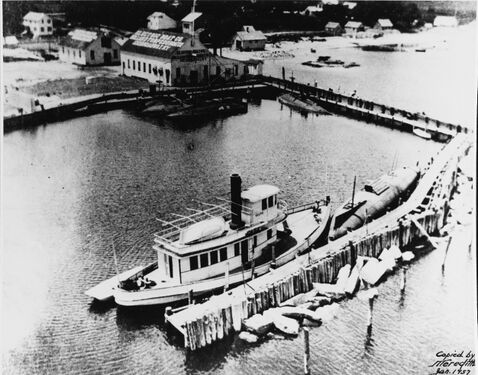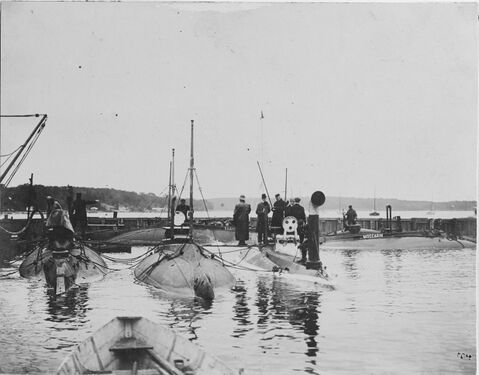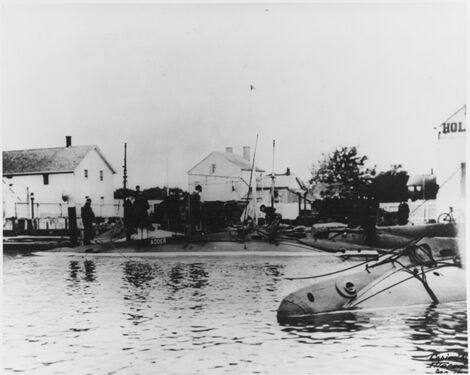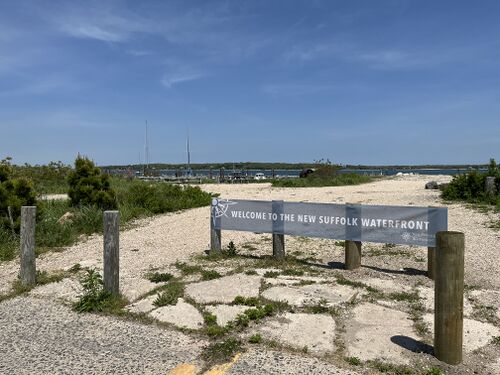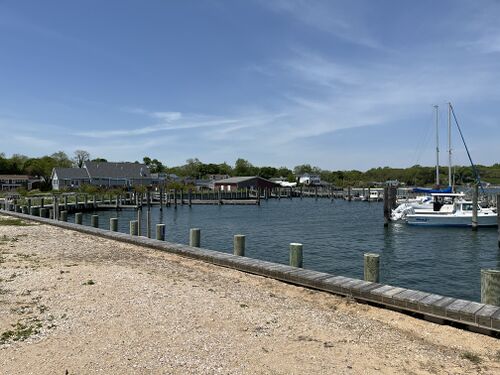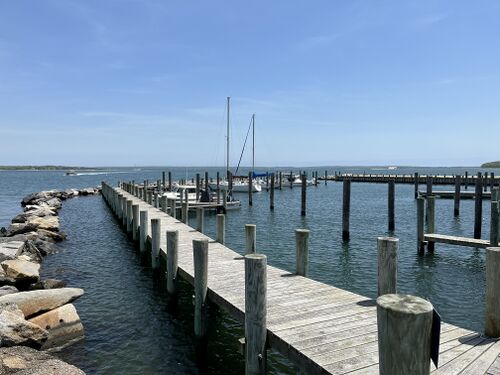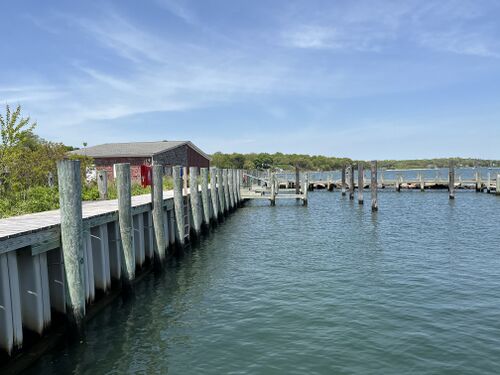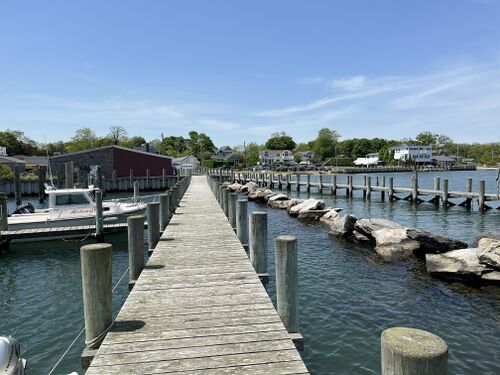Holland Torpedo Boat Company Station
The Holland Torpedo Boat Company Station
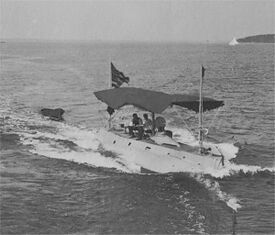
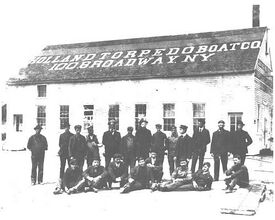
The trials of the Holland VI on Great Peconic Bay were entirely successful and after a haulout for minor modifications and repairs at Greenport, NY and one more trial run the boat was finally purchased by the Navy in April, 1900 and commissioned as the Holland on October 12, 1900. Electric Boat, however, was already looking to the future. Entirely at their own expense they contracted with Crescent Shipyard to build a larger and improved version of the Holland, with the intent of using her as a demonstration model for seven copies that Rice was working diligently to get the Navy to purchase. This new boat, called Fulton, was quickly moved to New Suffolk for testing and demonstration trials. The Fulton trials were entirely successful and they cleared the bureaucratic log jam around the authorization for the seven Adder-class submarines, five of which quickly followed the Fulton to New Suffolk (the other two were built in San Francisco).
-
The EB/HTBC facility at New Suffolk. The tug Kelpie is in the foreground, with the hulk of the 1895 Plunger moored ahead of it. In the background are several of the Adder-class submarines. Note the sign on the roof of the machine shop/draftsman's shop.
-
Several of the Adder-class boats moored at the northern corner of the basin. Moccasin (Submarine No. 5) is in the right background.
-
A view looking back from about half-way down the quay wall. Adder (Submarine No. 3) is in the background.
Fulton, Adder, Plunger, Moccasin, Porpoise, and Shark were joined in New Suffolk by a company owned tugboat called the Kelpie, which accompanied the boats as they made their initial trial runs in Great Peconic Bay. In addition, the hulk of a never completed steam powered submarine contracted to Holland's company in 1895 (also called the Plunger) was towed up to the station and moored to the quay wall inside the basin. Sleepy little New Suffolk became a busy and prosperous place for several years, with the new Adder-class submarines arriving regularly and trials being run out in the bay. New Suffolk was far enough away from New York City to keep the public and press at bay, but Rice was savvy enough to understand the advantages of getting favorable publicity and thus selected members of the press were often invited out to view the comings and goings around the station. The nearby southern shore of Long Island was also becoming a popular destination for summer vacations of the New York elite, and thus viewing the submarine movements became a favored pastime for Rice's urban colleagues. In addition, many high ranking Naval officers visited the site to see how the boats performed. Of course, the town played host to the incoming crews of the new submarines.
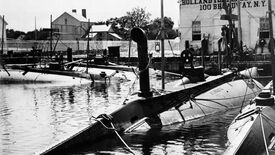
The site stayed in the Tuthill family and continued to operate as a boatyard and eventually a fuel oil distribution site. The family sold off the oil business in 1976. Mr. J. Arthur Kenniff purchased the boatyard portion in 1960 and built and repaired boats there until at least 1983. Eventually the site came under the ownership of the local Cutchogue/New Suffolk government. There was a plan at one point of developing the site with condominiums, but that never came to pass due to opposition by local residents. Today, the site is called "The New Suffolk Waterfront", with the old Holland basin the mooring site of several small yachts and boats.
New Suffolk has reverted to its pre-Holland 1899 ideal. The town is charming and quaint, with modest but stately homes gracing the hilly streets. Life seems to run at a slower pace there, and the approximately 500 residents seem to like it that way. As far as can be determined, no buildings from either the Goldsmith & Tuthill days or the HTBC residency remain. However, there is one building at the northern corner of the basin that sits on the site of the old machine shop building.
-
A cheerful sign belies the quaint nature of the old Holland basin. Photo by Dave Johnston, May 2024.
-
The end of the rip-rap quay wall. This is where the Kelpie and the 1895 Plunger were moored in the first gallery photo above. Photo by Dave Johnston, May 2024.
-
Looking back over the basin to the northwest. Photo by Dave Johnston, May 2024.
-
View from the north corner of the basin, looking down the "hook" of the quay wall. Photo by Dave Johnston, May 2024.
-
Looking to the north corner of the basin. This view corresponds to the middle photo in the gallery above. Photo by Dave Johnston, May 2024.
-
Looking back up the long dock to the north corner. The building in the background sits on the site of the old Holland machine shop, the one with the sign on the roof. Photo by Dave Johnston, May 2024.
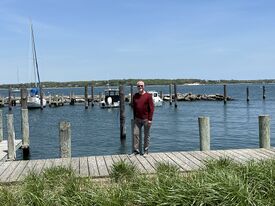
The people who currently live in the area keep the memory of the submarine activities alive by keeping up the site and providing picnic tables. They are ably assisted by submarine veterans of the local chapter of USSVI. There is a flag pole that proudly flies the national ensign, and a memorial plaque that lets visitors know the significance of the area has been installed near the parking lot. Their enthusiasm for their past is evident in the plaque, but in reality the location could not be actually called a "base" in the traditional sense of the word. It was always a privately owned facility, with no official Navy presence here other than the inbound crews and the occasional high ranking officer. Even still, it is a fitting tribute to a small but significant part of the history and heritage of the United States Submarine Service. I would like to express my thanks to the people of Cutchoque/New Suffolk and to my brothers in USSVI for their efforts in preserving the site for our posterity.
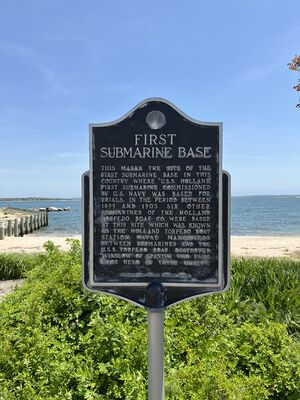
Page created by:
David Johnston
2024 - PigBoats.COM©
Norfolk, VA
webmaster@pigboats.com

